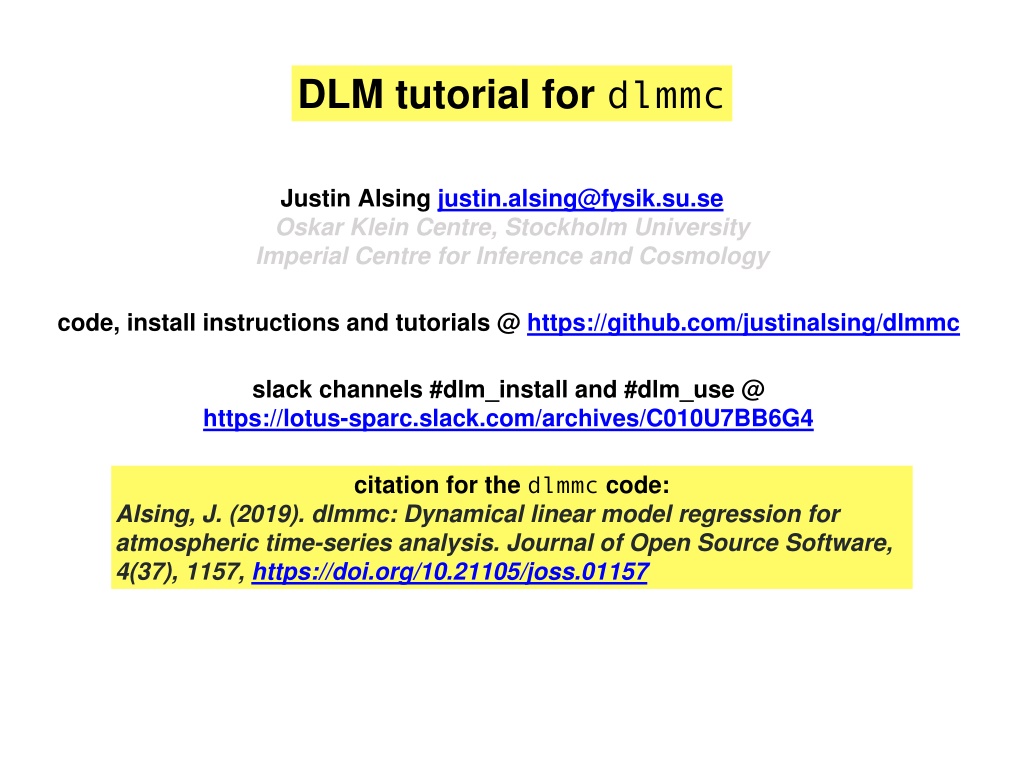
Bayesian Inference in Dynamical Linear Model Regression
Explore Bayesian inference concepts and applications in dynamical linear model regression with dlmmc code. Understand the theory behind DLM, use Bayes' theorem for posterior estimation, and learn through simple worked examples. Access tutorials and installation instructions for dlmmc.
Download Presentation

Please find below an Image/Link to download the presentation.
The content on the website is provided AS IS for your information and personal use only. It may not be sold, licensed, or shared on other websites without obtaining consent from the author. If you encounter any issues during the download, it is possible that the publisher has removed the file from their server.
You are allowed to download the files provided on this website for personal or commercial use, subject to the condition that they are used lawfully. All files are the property of their respective owners.
The content on the website is provided AS IS for your information and personal use only. It may not be sold, licensed, or shared on other websites without obtaining consent from the author.
E N D
Presentation Transcript
DLM tutorial for dlmmc Justin Alsing justin.alsing@fysik.su.se Oskar Klein Centre, Stockholm University Imperial Centre for Inference and Cosmology code, install instructions and tutorials @ https://github.com/justinalsing/dlmmc slack channels #dlm_install and #dlm_use @ https://lotus-sparc.slack.com/archives/C010U7BB6G4 citation for the dlmmc code: Alsing, J. (2019). dlmmc: Dynamical linear model regression for atmospheric time-series analysis. Journal of Open Source Software, 4(37), 1157, https://doi.org/10.21105/joss.01157
Bayesian inference (conceptual intro) DLM theory (give intuition) DLMing with dlmmc
Bayesian inference (Bayes theorem) some parameters we are interested in some observations we have made likelihood of getting our data for different values of the parameters this is what we want; it s called the posterior density prior beliefs about the parameters before we made any observations pesky normalizing constant called the evidence
Bayesian inference (as a process) (1) Decide what your prior beliefs are about the parameters , write down your prior (2) Write down your modeling assumptions, use this to derive the likelihood (3) Use Bayes' theorem to give you the posterior (up to a normalization) which you plug into an MCMC sampler to draw samples from the posterior
Bayesian inference (simple worked example) I want to weight my baby. I put him on the scales 5 times and make measurements: I ll assume that the scales give Gaussian uncertainties with zero mean and unknown . So my unknown parameters are: Alright let s infer !
Bayesian inference (simple worked example) (1) What are my prior beliefs on these parameters? (2) What are my modeling assumptions and hence likelihood? Each measurement is independent (iid) with Gaussian errors independent Gaussian (3) Plug into sampler and run
Bayesian inference (simple worked example) Let s have a look at the samples then knowledge about the mass marginalized over all uncertainty about sigma knowledge about sigma marginalized over all uncertainty about the mass samples
MLR . . . Data
MLR Parameters Careful Bayesian analysis: explore joint posterior , job done! Also: We usually do an approximation to this: - PWLT is not ideal for describing real trends - MLR is restrictive; we want a more expressive model - Make assumptions about the noise - Post hoc correction for correlated residuals - De-seasonalize first - Parameters estimated with approximate error bars
DLM model Regression coefficients are now dynamic
DLM model Seasonal coefficients are now dynamic
DLM model Trend is now dynamic
DLM priors Hyper-parameters of the DLM model how wiggly can the trend be? how much can the seasonal cycle vary? how much can the regressor amplitudes vary? AR process parameters uniform priors (set internally) chosen by you!
DLM inference with dlmmc We explore the joint posterior of all DLM model parameters by MCMC sampling Once the model is specified, we make no further approximations when recovering parameters All uncertainties, correlations, heteroskedastic noise, autoregressive terms, missing data etc are treated exactly
DLM inference with dlmmc Choose a DLM model set-up (which features are on/off) samples from the posterior of all DLM model components (trend, seasonal, regressor amplitudes etc) Load in your regressors and your data dlmmc Choose your priors on the hyper-parameters (smoothness of the trend etc)
Now its time to get DLMing! Download the code and follow the install instructions @ https://github.com/justinalsing/dlmmc Go to your dlmmc directory (where you just downloaded the code) and open a jupyter notebook (ie., just type jupyter notebook in the terminal in that directory). For python novices who haven t used jupyter before, see https://jupyter-notebook.readthedocs.io/en/stable/notebook.html Open the notebook dlm_tutorial.ipynb and read it through, executing the cells (shift+enter) as you go. This will take you through everything you need to know: loading in your data and regressors, preparing them for input to the DLM, calling the DLM, and making nice plots from the outputs Good luck and happy DLMing! If you get stuck or have any questions please please just contact me @ justin.alsing@fysik.su.se and I ll do my best to solve your problems! And finally, when you use the code please remember to cite the paper :) Alsing, (2019). dlmmc: Dynamical linear model regression for atmospheric time-series analysis. Journal of Open Source Software, 4(37), 1157, https://doi.org/10.21105/joss.01157
